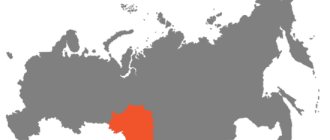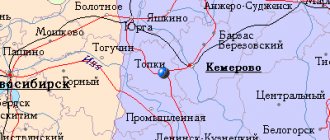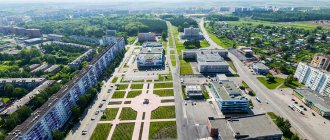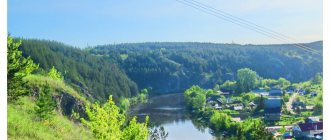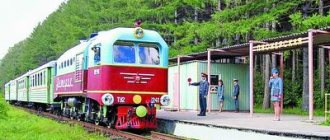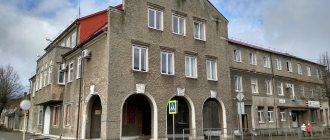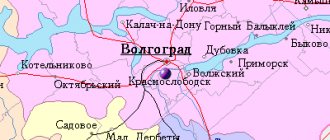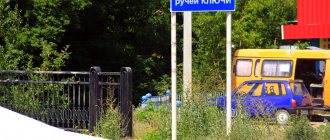| Coat of arms of Berezovsky (Kemerovo region) | |
| A country | Russia |
| Subject of the federation | Kemerovo region |
| Urban district | Berezovsky city |
| Chapter | Chernov Sergey Fedorovich |
| Based | 1965 |
| Population | ▲ 47,388[1] people (2010) |
| Vehicle code | 42 |
| City with | 1965 |
| Timezone | UTC+7 |
| OKATO code | 32 410 |
| Agglomeration | 49 600 |
| Telephone code | +7 38445 |
| Official site | https://www.berez.org/ |
| Square | 0.0746 km² |
| Postcode | 652420 |
| Coordinates | Coordinates: 55°40′00″ N. w. 86°15′00″ E. d. / 55.666667° n. w. 86.25° E. d. (G) (O) (I)55°40′00″ n. w. 86°15′00″ E. d. / 55.666667° n. w. 86.25° E. d. (G) (O) (I) |
Berezovsky is a city in the Kemerovo region of Russia, the center of the urban district "city of Berezovsky".
Population 47.4 thousand people. (2009).
General information and history of the city
Berezovsky is located in the Kuznetsk Basin, in the interfluve of the Barzas and Shurap rivers (Ob basin), 27 km north of Kemerovo. Railway station Biryulinskaya and Zaboishchik.
Berezovsky
The village of Berezovsky arose in 1949 during the construction of the Berezovskaya mine; It most likely got its name from the abundance of birch trees in the area.
The city of Berezovsky was formed in 1965 from the villages of Kurganovka, Berezovsky and Oktyabrsky.
Stella at the entrance from Cherniga and Barzas
The city is located near the M53 highway (to Mariinsk, Krasnoyarsk and further to the east), but this does not give the city any advantages.
Entry from the P-255 highway, also known as M53
Few people know that a century ago Kolchak’s army passed through the city, retreating to the east. They passed through the village of Dmitrievka, where they still find various objects - from coins to weapons. One city resident has a Maxim machine gun in his garden, a living witness and participant in those events. In history, this transition is called the Great Siberian Ice March. In the city, few people study it, as well as the history of the region (there are enthusiasts and history buffs).
Museum named after V.N. Plotnikova
Russian empire
It is known that the territory of the modern Kemerovo region was inhabited several thousand years ago. In 1618, the Kuznetsk fort was founded in the south of the future region. It was intended to protect Russian lands from Dzungar and Mongol invaders. In 1698, the second oldest settlement in this area appeared - Mariinsk.
Since 1721, the development of mineral deposits began here. The first to discover the burning coal seam was ore explorer Mikhailo Volkov. He is considered the discoverer of the famous Kuznetsk coals.
At the end of the 18th century, intensive development of the region began. Demidov factories are being built, which later become state property.
Throughout the 19th century, the territory of the modern Kemerovo region was part of the Tomsk province. These were Mariinsky and Kuznetsk districts. It was then that many new industrial enterprises appeared: silver smelting, iron making, factories, mining mines. The industry of Kuzbass is undergoing rapid development after the completion of the Trans-Siberian Railway.
Population
The city's population continues to decline. If in the early 90s about 52 thousand people lived in Bereza, as the locals call it, then in 2015 the number of Berezovka residents officially decreased to 47 thousand. There is a noticeable trend for young people to leave the city. As elsewhere, school graduates go to Tomsk, Kemerovo, Novokuznetsk, Novosibirsk, and some go to Moscow with St. Petersburg, where they then settle in new places, form families and are in no hurry to return.
The main increase in population comes from migration from neighboring villages, villages, as well as visitors from Kazakhstan.
Almost the entire adult population works in mines, open-pit mines and related market segments.
Creating a region
The official history of the formation of the Kemerovo region begins on January 26, 1943. Then the Presidium of the Supreme Council decides to separate Kuzbass from the Novosibirsk region into a separate region. Kemerovo becomes its administrative center. This is the history of the creation of the Kemerovo region.
The new region includes nine of the 12 cities of regional subordination, most of the workers' villages, and 23 of the 75 districts. The population of the new Kemerovo region is 42% of the Novosibirsk region.
The post-war history of the Kemerovo region has seen rapid industrial growth. This leads to the emergence of new cities.
Climate and ecology
The climate, as throughout the entire territory of Kuzbass, is sharply continental, cold in winter, sometimes up to 30 and below, in summer it is hot over +30 (at times). And so, in summer the temperature averages 20 degrees Celsius.
Recently, the climate on the planet and in the region has been bringing its own surprises: with snow in June and thaws in February. If earlier throughout the winter the temperature was below 20 degrees, and February was freezing, and the snow began to melt only at the end of March or beginning of April, now at the end of February it is around zero, and a week later - minus 20. In general, we live happily!
Snow in summer!
The ecological situation is more or less rosy. Pollution mainly comes from transport. There are not many enterprises within the city limits, they are all at a fairly large distance, but of those that are close:
- City boiler house - heated with coal, hence the emissions of soot into the air, there is a regular layer of dirt on the windows, children are not recommended to chew on icicles, because there are black inclusions of soot and combustion products,
- Berezovskaya Central Processing Plant is located not far from the city, sometimes the wind blows in coal drying products.
All waste accumulates around enterprises (these are processing plants, mines and open-pit mines), the snow there is white only in the first minutes after it falls.
Current situation
The modern history of the Kemerovo region turned out to be not so rosy. What happened in the region in the 90s affected the development of not only Kuzbass, but the entire country.
The regional economy finds itself in a deep systemic crisis. In conditions of shortages, industrial enterprises, including large ones, begin to close.
As a result of the privatization of state property, the state retains only part of its resources. These are railway transport, the defense complex, gold mining, veterinary and sanitary-epidemiological institutions. Printing houses, pharmacies, poultry farms, and some motor transport enterprises are subordinated to the region. Municipal authorities manage only hospitals and clinics, schools, public utilities, and residential buildings. Everything else becomes private property.
Despite the fact that the economy was in decline in the 90s, by the end of the decade the coal industry began to develop. Since 2003, oil refineries have been operating in the Kemerovo region. This has become a new industry for the region. Since 2010, coal gas production, a project for the extraction and use of methane from coal seams, has been implemented.
For more than 20 years, the region was led by Governor Aman Tuleyev, an influential politician who even ran for the presidency of Russia in the 90s. In 2022, he resigned after the shopping tragedy, when a fire killed 60 people. Now the region is headed by Sergei Tsivilev.
Districts and real estate
The city is not big, therefore there are not many districts. The city consists of 3 main districts:
- Village of the Yuzhnaya mine (Yuzhnaya, Yuzhanka),
- Berezovskaya mine village (Beryozovka),
- Central microdistrict (Mikrashka, center). At the same time, Mikrashka consists of several mini-districts: Oktyabrsky, 4th microdistrict (Chetverka), Volkova, VGSCH, Solnechny, Fedorovka.
Map of Berezovsky districts
Real estate prices, as throughout the country in small towns: 1st - about 1 million rubles, 2nd - 1.5-2 million rubles, 3rd - from 1.8 million rubles. These are prices for resale, a little more expensive for new buildings. Houses are sold from 500 thousand rubles, depending on condition. Due to the “crises,” housing prices fell slightly. More expensive real estate in the Center, on Berezovka and Yuzhnaya, the price is slightly lower (200 thousand).
Culture
There are 11 creative groups in the city, bearing the title “folk” and “exemplary”. By tradition, for a number of years the city has been hosting a regional festival of children’s and youth folklore groups, “Christmas in Berezovsky.”
City creative teams have repeatedly been laureates and winners of regional and All-Russian competitions. Choreographic ensembles “April” and “Tausen” under the direction of Honored Cultural Worker Larisa Terekhova participated in the International Festivals “Golden Amphora” (Greece) and “Joy of Europe” (Yugoslavia).
Infrastructure
Utilities in the city cost about the same as in other cities in the region.
Tariffs (all data as of July 2015):
- heating - RUB 2,242.89/Gcal;
- cold water - 34.72 rubles / cubic meter. meter;
- hot water - 198.49 rubles / cubic meter. meter;
- water disposal - 23.98 rubles/cu.m. meter;
- fee for major repairs - 3.9 rubles/sq. meter;
- electricity - 2.05 / kWh.
The problem of transport is relevant. The city has one municipal route No. 1, which can wait an hour, there is a connection with Kemerovo - route No. 120, nearby villages and with the suburb of Kemerovo - Kedrovka (route No. 121).
There is nowhere to go except one cafe, a movie at the City Center for Creativity and Leisure (GCCLD), children can be sent to a music school or art school. There are enough kindergartens, as well as schools.
Secondary vocational education can be obtained at the Vocational Lyceum (cook, electrician, driver and some others). For higher education you need to go to Kemerovo.
City Center for Creativity and Leisure
Enterprises and work
The city lives by coal mining; Berezovsky’s main employer is the Chernigovets open-pit mine. Miners' salaries are not high. The highest paid workers are excavator operators and BelAZ drivers - about 40t. R. and higher, the rest receive about 20-25 thousand rubles, despite the fact that a regional coefficient of 30% applies. Miners have a salary in the range of 20-30 thousand rubles, mining sites earn more, and those on the surface - maybe 15 thousand rubles.
Among the enterprises, we will highlight the large ones - Chernigovets, the Berezovskaya and Pervomaiskaya mines, the Severnaya processing plant, the Berezovskaya central processing plant, the Barzassky open-pit mine, and Rover.
Berezovskaya mine, management
Cherniga, Administrative and Household Plant (ABK)
But the main scourge of Kuzbass is the SDS - the Siberian Business Union. This structure has bought up the entire region and is actively establishing its own rules. The labor code is often not respected, overtime is not paid, and if you stay for dinner, you will only be given time off for the number of hours you spent at work. Stayed for 1.30, they will give you 1.30, and it doesn’t matter that you have to wait another 2 and a half hours for the service bus. Reviews about this organization are negative, but people have nowhere to go, because there is no other work in the city. So they adapt, or even change for the worse (set-ups are not uncommon, denunciation is practiced and valued).
That’s why many are fleeing Kuzbass, because in another city in the region there is the same SDS or its “daughter”.
Excerpt characterizing Berezovsky (Kemerovo region)
The door opened into the front and back. An old servant of the princesses sat in the corner and knitted a stocking. Pierre had never been to this half, did not even imagine the existence of such chambers. Anna Mikhailovna asked the girl who was ahead of them, with a decanter on a tray (calling her sweet and darling) about the health of the princesses and dragged Pierre further along the stone corridor. From the corridor, the first door to the left led to the princesses' living rooms. The maid, with the decanter, in a hurry (as everything was done in a hurry at that moment in this house) did not close the door, and Pierre and Anna Mikhailovna, passing by, involuntarily looked into the room where the eldest princess and Prince Vasily. Seeing those passing by, Prince Vasily made an impatient movement and leaned back; The princess jumped up and with a desperate gesture slammed the door with all her might, closing it. This gesture was so unlike the princess’s usual calmness, the fear expressed on Prince Vasily’s face was so uncharacteristic of his importance that Pierre stopped, questioningly, through his glasses, looked at his leader. Anna Mikhailovna did not express surprise, she only smiled slightly and sighed, as if showing that she had expected all this. “Soyez homme, mon ami, c'est moi qui veillerai a vos interets, [Be a man, my friend, I will look after your interests.],” she said in response to his gaze and walked even faster down the corridor. Pierre did not understand what the matter was, and even less what veiller a vos interets meant, [to look after your interests,] but he understood that all this should be so. They walked through the corridor into a dimly lit hall adjacent to the count's reception room. It was one of those cold and luxurious rooms that Pierre knew from the front porch. But even in this room, in the middle, there was an empty bathtub and water was spilled on the carpet. A servant and a clerk with a censer came out to meet them on tiptoe, not paying attention to them. They entered a reception room familiar to Pierre with two Italian windows, access to the winter garden, with a large bust and a full-length portrait of Catherine. All the same people, in almost the same positions, sat whispering in the waiting room. Everyone fell silent and looked back at Anna Mikhailovna who had entered, with her tear-stained, pale face, and at the fat, big Pierre, who, with his head down, obediently followed her. Anna Mikhailovna's face expressed the consciousness that the decisive moment had arrived; She, with the manner of a businesslike St. Petersburg lady, entered the room, not letting Pierre go, even bolder than in the morning. She felt that since she was leading the one whom the dying man wanted to see, her reception was guaranteed. Having quickly glanced at everyone who was in the room, and noticing the count's confessor, she, not only bending over, but suddenly becoming smaller in stature, swam up to the confessor with a shallow amble and respectfully accepted the blessing of one, then another clergyman. “Thank God we made it,” she said to the clergyman, “all of us, my family, were so afraid.” This young man is the count’s son,” she added more quietly. - A terrible moment! Having uttered these words, she approached the doctor. “Cher docteur,” she told him, “ce jeune homme est le fils du comte... yat il de l'espoir?” [this young man is the son of a count... Is there hope?] The doctor silently, with a quick movement, raised his eyes and shoulders upward. Anna Mikhailovna raised her shoulders and eyes with exactly the same movement, almost closing them, sighed and walked away from the doctor to Pierre. She turned especially respectfully and tenderly sadly to Pierre. “Ayez confiance en Sa misericorde, [Trust in His mercy,”] she told him, showing him a sofa to sit down to wait for her, she silently walked towards the door that everyone was looking at, and following the barely audible sound of this door, disappeared behind it. Pierre, having decided to obey his leader in everything, went to the sofa that she showed him. As soon as Anna Mikhailovna disappeared, he noticed that the glances of everyone in the room turned to him with more than curiosity and sympathy. He noticed that everyone was whispering, pointing at him with their eyes, as if with fear and even servility. He was shown respect that had never been shown before: a lady unknown to him, who was speaking with the clergy, stood up from her seat and invited him to sit down, the adjutant picked up the glove that Pierre had dropped and handed it to him; the doctors fell silent respectfully as he passed them, and stood aside to give him room. Pierre wanted to sit in another place first, so as not to embarrass the lady; he wanted to lift his glove himself and go around the doctors, who were not standing in the road at all; but he suddenly felt that this would be indecent, he felt that this night he was a person who was obliged to perform some terrible ritual expected by everyone, and that therefore he had to accept services from everyone. He silently accepted the glove from the adjutant, sat down in the lady’s place, placing his large hands on his symmetrically extended knees, in the naive pose of an Egyptian statue, and decided to himself that all this should be exactly like this and that he should do it this evening, so as not to to get lost and not do anything stupid, one should not act according to one’s own considerations, but one must submit oneself completely to the will of those who guided him. Less than two minutes had passed when Prince Vasily, in his caftan with three stars, majestically, holding his head high, entered the room. He seemed thinner since the morning; his eyes were larger than usual when he looked around the room and saw Pierre. He walked up to him, took his hand (which he had never done before) and pulled it down, as if he wanted to test whether it was holding tightly.
